
The North Clyde Line is a suburban railway in West Central Scotland. The route is operated by ScotRail. As a result of the incorporation of the Airdrie–Bathgate rail link and the Edinburgh–Bathgate line, this route has become the fourth rail link between Glasgow and Edinburgh.

Edinburgh Waverley is the principal railway station serving Edinburgh, Scotland. It is the second busiest station in Scotland, after Glasgow Central. The station serves as the northern terminus of the East Coast Main Line, 393 miles 13 chains from London King's Cross, although some trains operated by London North Eastern Railway continue to other Scottish destinations beyond Edinburgh.

The North British Railway was a British railway company, based in Edinburgh, Scotland. It was established in 1844, with the intention of linking with English railways at Berwick. The line opened in 1846, and from the outset the company followed a policy of expanding its geographical area, and competing with the Caledonian Railway in particular. In doing so it committed huge sums of money, and incurred shareholder disapproval that resulted in two chairmen leaving the company.
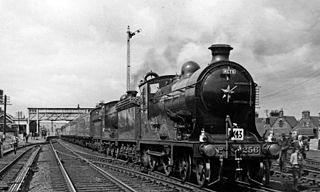
The Waverley Route was a railway line that ran south from Edinburgh, through Midlothian and the Scottish Borders, to Carlisle. The line was built by the North British Railway; the stretch from Edinburgh to Hawick opened in 1849 and the remainder to Carlisle opened in 1862. The line was nicknamed after the immensely popular Waverley Novels, written by Sir Walter Scott.
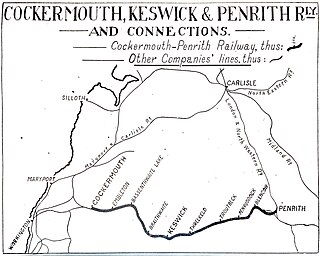
The Cockermouth, Keswick and Penrith Railway (CK&PR) was an English railway company incorporated by act of Parliament on 1 August 1861, to build a line connecting the town of Cockermouth with the London and North Western Railway (LNWR) West Coast Main Line at Penrith. Arrangements for the use of the stations at either end were included. Passenger and goods traffic was worked by the LNWR and mineral traffic by the North Eastern Railway, both of whom had shares in the company. The line was 31+1⁄2 miles (50.7 km) in length, and had eight intermediate stations.
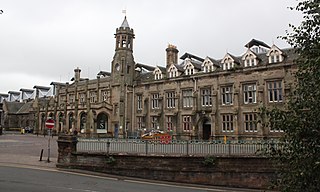
Carlisle railway station, or Carlisle Citadel, is a Grade II* listed railway station serving the cathedral city of Carlisle, Cumbria, England. It is on the West Coast Main Line, 102 miles (164 km) south-east of Glasgow Central and 299 miles (481 km) north north-west of London Euston. It is the northern terminus of the Settle and Carlisle Line, a continuation of the Midland Main Line from Leeds, Sheffield and London St Pancras. It was formerly the southern terminus of the partially-closed Waverley Route from Edinburgh. It is so named because it is adjacent to Carlisle Citadel, a former medieval fortress. The station is owned by Network Rail.
The Edinburgh and Glasgow Railway was authorised by act of Parliament on 4 July 1838. It was opened to passenger traffic on 21 February 1842, between its Glasgow Queen Street railway station and Haymarket railway station in Edinburgh. Construction cost £1,200,000 for 46 miles (74 km). The intermediate stations were at Corstorphine, Gogar, Ratho, Winchburgh, Linlithgow, Polmont, Falkirk, Castlecary, Croy, Kirkintilloch and Bishopbriggs. There was a ticket platform at Cowlairs. The line was extended eastwards from Haymarket to North Bridge in 1846, and a joint station for connection with the North British Railway was opened on what is now Edinburgh Waverley railway station in 1847.

Whitrope is a densely forested, but sparsely populated area, high in the Southern Upland hills in the south central Scottish Borders in the former county of Roxburghshire. Situated some 12 miles south from Hawick on the B6399 road, the Scottish watershed passes through the area; Whitrope Burn draining south towards Newcastleton and Flosh Burn draining north towards Hawick.
The Edinburgh Suburban and Southside Junction Railway was a railway company that built an east-west railway on the southern margin of Edinburgh, Scotland, primarily to facilitate the operation of heavy goods and mineral traffic across the city. The line opened in 1884. Although its route was rural at the time, suburban development quickly caught up and passenger carryings on the line were buoyant; the passenger service operated on a circular basis through Edinburgh Waverley railway station.

The Edinburgh and Dalkeith Railway was an early railway built to convey coal from pits in the vicinity of Dalkeith into the capital. It was a horse-operated line, with a terminus at St Leonards on the south side of Arthur's Seat.

Galashiels is a railway station on the Borders Railway, which runs between Edinburgh Waverley and Tweedbank. The station, situated 33 miles 22 chains (54 km) south-east of Edinburgh Waverley, serves the town of Galashiels in Scottish Borders, Scotland. It is owned by Network Rail and managed by ScotRail.
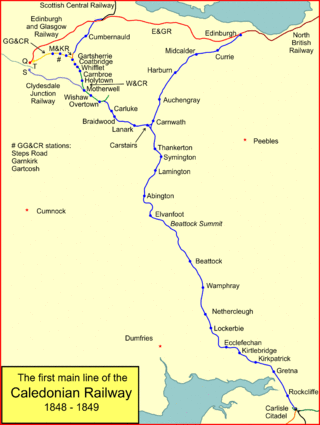
The Caledonian Railway main line in Scotland connected Glasgow and Edinburgh with Carlisle, via Carstairs and Beattock.
The Border Counties Railway was a railway line connecting Hexham in Northumberland, with Riccarton Junction on the Waverley Route in Roxburghshire.

The Border Union Railway was a railway line which connected places in the south of Scotland and Cumberland in England. It was authorised on 21 July 1859 by the Border Union Railways Act 1859 and advertised as the Waverley Route by the promoters - the North British Railway. It connected the Edinburgh and Hawick Railway at Hawick with Carlisle.

The Tyne Valley Line is a 58-mile (93 km) route, linking Newcastle upon Tyne with Hexham and Carlisle, England. The line follows the course of the River Tyne through Tyne and Wear and Northumberland. Five stations and two viaducts on the route are listed structures.
There were two interlinked railways on the south shore of the Solway Firth.

The Newcastle & Carlisle Railway (N&CR) was an English railway company formed in 1825 that built a line from Newcastle upon Tyne on Britain's east coast, to Carlisle, on the west coast. The railway began operating mineral trains in 1834 between Blaydon and Hexham, and passengers were carried for the first time the following year. The rest of the line opened in stages, completing a through route between Carlisle and Gateshead, south of the River Tyne in 1837. The directors repeatedly changed their intentions for the route at the eastern end of the line, but finally a line was opened from Scotswood to a Newcastle terminal in 1839. That line was extended twice, reaching the new Newcastle Central Station in 1851.

The Newbattle Viaduct, sometimes also called the Lothianbridge, Newtongrange or Dalhousie Viaduct, carries the Borders Railway, which opened in 2015, over the River South Esk near Newtongrange, Midlothian, Scotland.

The Borders Railway connects the city of Edinburgh with Galashiels and Tweedbank in the Scottish Borders. The railway follows most of the alignment of the northern part of the Waverley Route, a former double-track line in southern Scotland and northern England that ran between Edinburgh and Carlisle. That line was controversially closed in 1969, as part of the Beeching cuts, leaving the Borders region without any access to the National Rail network. Following the closure, a campaign to revive the Waverley Route emerged. Discussion on reopening the northern part of the line came to a head during the early 2000s. Following deliberations in the Scottish Parliament, the Waverley Railway (Scotland) Act 2006 received royal assent in June 2006. The project was renamed the "Borders Railway" in August 2008, and building works began in November 2012. Passenger service on the line began on 6 September 2015, whilst an official opening by Queen Elizabeth II took place on 9 September.
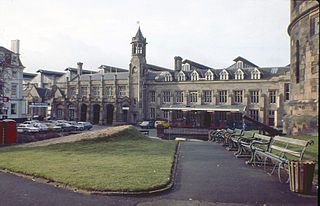
Carlisle, in North West England, formed the focus for a number of railway routes because of the geography of the area. At first each railway company had its own passenger and goods station, but in 1847 passenger terminal facilities were concentrated at Citadel station, which is in use today. Goods facilities remained dispersed, and goods wagons passing through were remarshalled, incurring delay and expense.

















